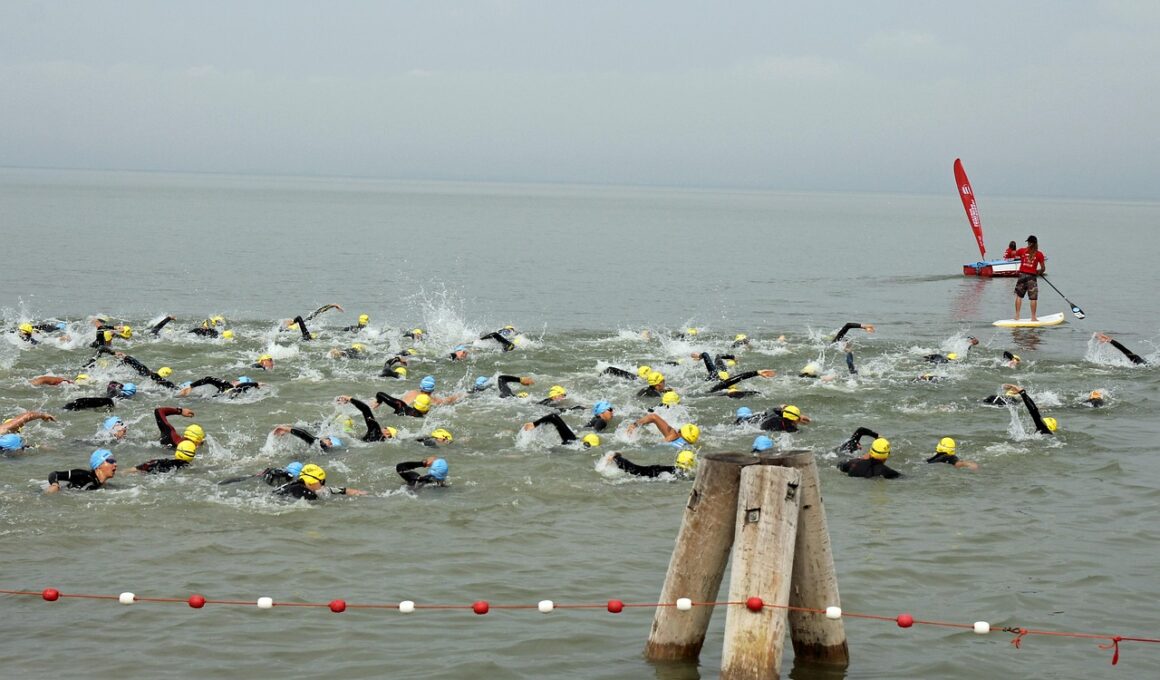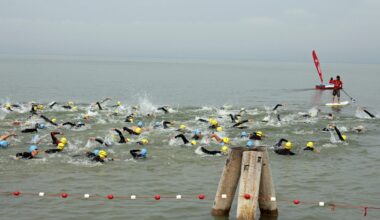How to Dress Appropriately for Cold Water Swimming
Cold water swimming is exhilarating but requires the right approach to ensure safety and comfort. Before you dive into chilly waters, it’s crucial to understand what suitable clothing choices are. First, always prioritize thermal insulation, which helps maintain body temperature in colder environments. Specialized wetsuits provide excellent insulation and should fit closely without constricting movement. Look for materials like neoprene, which offer both warmth and flexibility. Accessories are also vital; consider wearing a swim cap to minimize heat loss, as most body heat escapes through the head. Waterproof gloves and boots can protect extremities, adding warmth and comfort during prolonged exposure. Planning your gear also means respecting your specific needs; for individuals prone to cold sensitivity, additional layers or a thicker wetsuit may be advisable. Don’t forget to have easy-to-remove layers ready for after your swim, as quickly changing out of wet gear can prevent hypothermia. Finally, always check local water temperatures and conditions before swimming. Being informed will help prepare you better for the wonderful experience ahead, while keeping you safe and comfortable in the cold water.
The Importance of Wetsuits
When it comes to cold water swimming, wetsuits are indispensable. They are specially designed to provide warmth and buoyancy, allowing swimmers to perform efficiently in lower temperatures. A properly fitted wetsuit traps a thin layer of water between the suit and the skin, which warms up from your body heat and acts as insulation. Thickness is key; suits can range from 2mm for warmer areas to 5mm for intense cold waters. Make sure that the suit fits well, as a loose wetsuit can cause water to flow in and out, compromising warmth. Additionally, different wetsuit styles are available; full suits provide maximum coverage, while shorties and sleeveless versions offer more freedom of movement. Furthermore, wetsuit features such as glideskin necklines can prevent water entry and enhance comfort. Choosing a wetsuit suited to your swimming style and conditions enhances your experience drastically. Remember to take care of your wetsuit by rinsing it after each use to prolong its life. This care ensures that your investment stays effective for countless chilly swimming adventures ahead.
Layering is an essential strategy for cold water swimmers. By incorporating multiple layers, swimmers can adjust their clothing according to changing water temperatures or weather conditions. Start with a moisture-wicking base layer to draw sweat away from your body, keeping you dry throughout your swim. This is particularly important because wet clothing can lead to a rapid loss of body heat. Over this base, a thermal or insulating layer is beneficial; materials such as fleece or specialized swim fabrics offer great warmth. Choose a waterproof outer layer as a windbreaker or waterproof jacket. This additional layer will provide comfort against the elements, especially on windy days. Furthermore, suitable thermal swim caps can add significant warmth, while thermal gloves prevent heat loss from your hands. Always remember to acclimatize your body to cold water before swimming, as various clothing items may feel heavy or uncomfortable initially. Testing your gear in similar conditions is essential to find the best combination for your needs. Each component of your attire should work harmoniously to ensure you enjoy your cold water experience without compromising performance or comfort.
Accessories for Enhanced Comfort
In addition to wetsuits and layers, the right accessories greatly improve your cold water swimming experience. Swim caps are not only important for warmth but also help reduce drag in the water, increasing your speed and efficiency. Consider wearing neoprene or silicone caps to trap warmth effectively. Gloves, specifically designed for swimming, will allow for dexterity and warmth during colder swims. Neoprene gloves, like wetsuits, provide insulation while letting you retain some hand movement for better strokes. Also, thermal booties are highly recommended, as they help protect your feet from the cold seabed while adding extra warmth. In addition to these items, brightly colored caps or floats can enhance visibility in cold waters, especially when swimming in outdoor locations. It’s crucial to be visible to yourself and your surroundings during low temperature swims, mainly due to reduced visibility in colder waters. Ultimately, investing in quality accessories tailored for cold swimming can elevate your experience, making it enjoyable and safe. Prioritizing comfort through proper gear ensures that you can focus on enjoying the invigorating aspects of your cold water swimming adventures.
Preparation also involves understanding how to transition from land to water smoothly. Before entering the cold water, good warm-up routines help your body adjust gradually. This process is essential to avoid shock when entering chilly temperatures. A good warm-up might include dynamic stretches or light exercises to raise your heart rate and blood flow. Also, consider taking a dip or splash of cold water on your body parts, like arms or legs, to condition your body when entering the water. Proper hydration is equally vital; even in cooler temperatures, the body can dehydrate quickly, compromising performance during your swim. Staying well-hydrated helps regulate body temperature and supports overall endurance. Post-swim routines are as important; even after a fantastic cold swim, remember to have warm drinks and dry yourself quickly. Changing into warm clothes after your swim helps your body temperature stabilize while preventing chills. Furthermore, engaging in light activities, like walking or stretching after swimming, can help you to gradually regulate your body temperature back to normal. Paying attention to these transitions is a key component of a positive cold water experience.
After-Care and Recovery
Recovery is essential after cold water swimming to ensure your safety and overall well-being. After enjoying a swim, it’s vital to dry off as soon as possible to preserve body heat. Be sure to have warm, dry clothes on hand, quickly changing out of your wet gear. This swift transition helps mitigate the risk of hypothermia. Once changed, warm yourself with hot drinks, such as herbal teas or warm water mixed with honey. Not only do these drinks help restore body warmth, but they also replenish lost fluids. If you find yourself feeling particularly chilled after a swim, consider taking a warm shower; this can relax your muscles as well and help aid recovery. Nutritional recovery is also critical; consuming a healthy meal afterward provides energy and promotes muscle recovery. Foods rich in carbohydrates and proteins will help in replenishing glycogen stores used during your swim. Additionally, allow your body some recovery time before engaging in another swim to prevent fatigue. Taking care of your body post-swimming is just as important as pre-swimming preparations, ensuring you stay healthy and ready for your next dip.
In summary, dressing appropriately for cold water swimming involves a combination of specialized gear, layering strategies, and essential accessories that enhance comfort and safety. Prioritizing wetsuits that provide thermal insulation and correctly layering your clothing allows for better control of body temperature. Using accessories like swim caps, gloves, and thermal booties can further enhance comfort and reduce heat loss while swimming in chilly conditions. Preparing your body properly with warm-ups, hydration, and gradual acclimatization helps transition into the cold water experience seamlessly. Post-swimming care is equally important, prioritizing quick drying, warming up, and nutritional recovery to maintain well-being after your swim. Embrace the invigorating nature of cold water swimming with the right preparations and gear. This approach not only makes your experience enjoyable but also safe and fulfilling. With attention to detail in outfit choices and self-care routines, you can conquer cold water swimming challenges. Look forward to many refreshing and fruitful cold swimming adventures ahead, equipped with the knowledge and tools to enjoy every moment! Remember, safety comes first as you navigate through the alluring world of cold water swimming.



